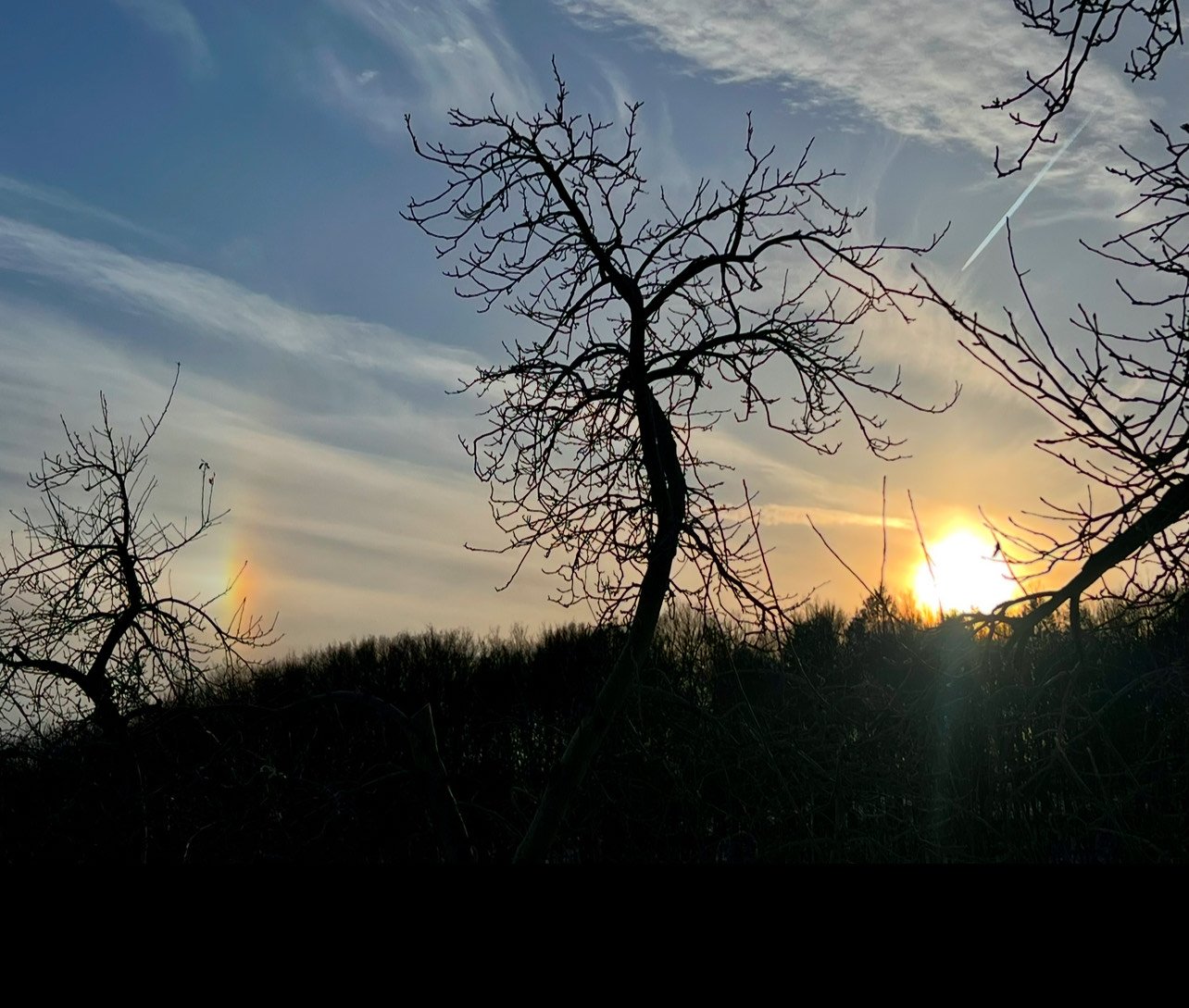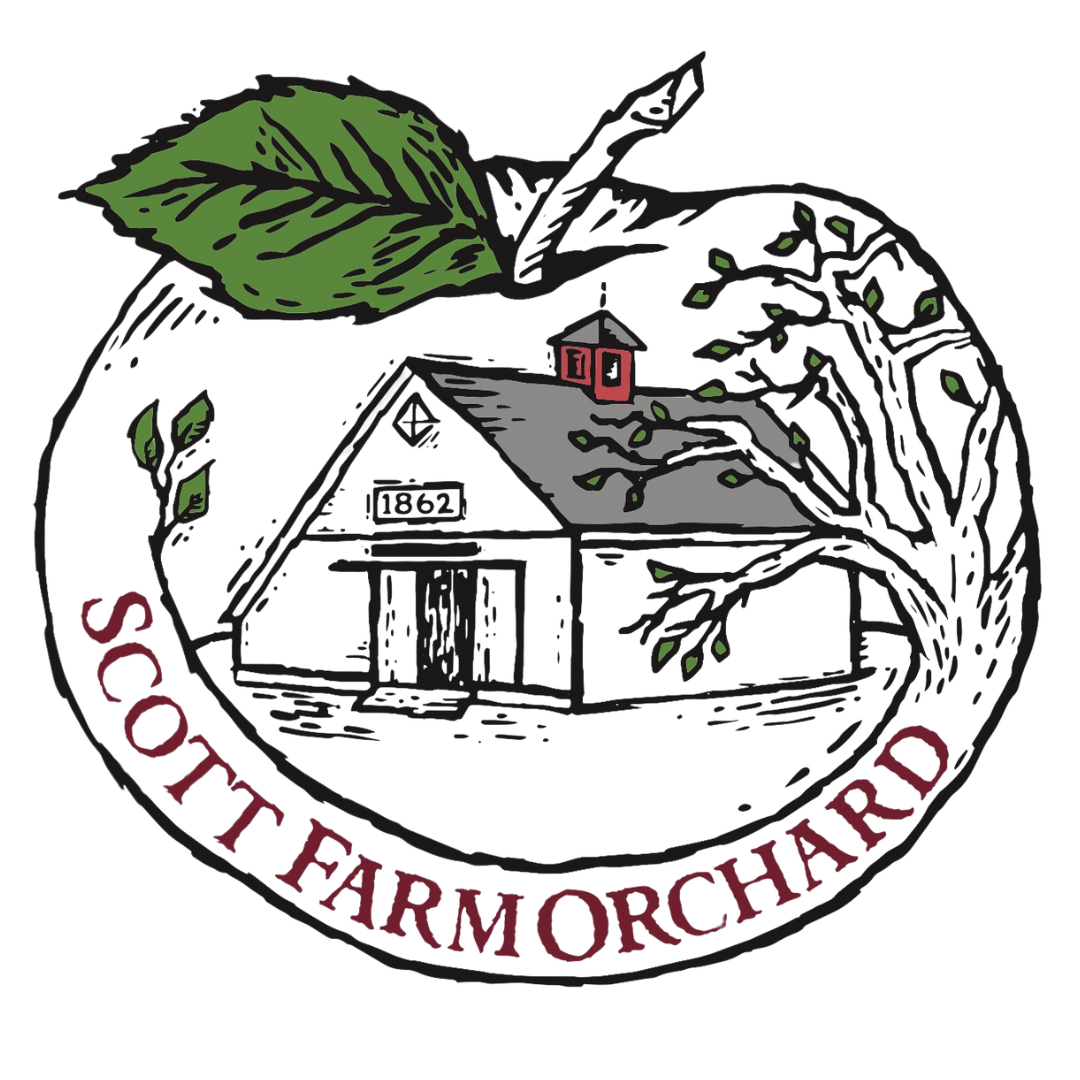
Growing with Change
by Scott Farm Orchardist Erin Robinson
Originally published in Issue 25, Summer 2024 of Malus, a quarterly print journal featuring bittersharp criticism and commentary by great cider thinkers in America and beyond. To purchase the issue or subscribe, visit maluszine.com.
Transition is a noun defined as the process or period of changing from one state or condition to another. In other words, a perpetual state of adapting to the circumstances we are in on both a micro and macro scale. Circumstances or events which are shifting minute by hour, hour by day, day by season, ever ticking onward. How granular and broadly this single word impacts our every movement, thought processes, decision making and future planning. It is an infinite, subconscious and intentional flow of eternal adjusting. A remarkable human trait.
Outside my window, the breeze is silky and rich with lilac, mown grass and honeysuckle. A thousand shades of green dancing across the canopy, under a robin’s egg blue sky, while a symphony of lark and jay grace my stage. Not one week ago was the orchard snowballed with fragrant bloom, humming with bees intoxicated by the abundance of pollen, the orchard so alive with feasting fervor. A few short weeks before that, the trees were barely awake, a slow emergence from their long slumber of dormancy, the chill and fear of cold nights still threatening their tender buds, and our tender hearts. Now, the pollinator buzz of the orchard has fallen silent, petals dropped and withering to brown confetti on the ground, revealing in their wake tiny fruitlets dancing over every limb as far as the eye can see, the potential boundless, the challenges just as great.
“How did that happen so fast” I think to myself, “Its almost June already!?” This familiar mantra becomes the catch phrase to the tail end of every warm month going forward.
As an apple grower, spring is a literal whirlwind of hasty transitions. I switch from months of deep winter pruning- slow, steady and thoughtful work, quietly plugging along at a low-pressure pace. Days are filled with losing myself in audiobooks and studying the naked secrets the trees have revealed, contemplatively deciding their future forms. Then, suddenly, no matter how well planned, spring explodes into its magnificent glory. Fungal, bacterial and pest filled life manifesting into every inch and pore of the orchard world. Discussions, decisions, tasks often changing multiple times throughout a single day, transitioning with every shift of the wind. Apple scab models spin me in actual circles, grumbling ensues, with the weather always and ultimately deciding my fate. Fire Blight looms, its vicious scorched destruction threatening every lingering late bloom and untimely passing rain shower. Fruitlets, watched to the millimeter, awaiting the ever dreaded, oh so complicated, no grower is ever really sure of, task of thinning. Meanwhile, grass is soaring up in the blink of an eye, fertilizing awaits the rain and the perpetual state of feeling behind swiftly settles in. Yet, I persist, I do get it done and I do make the final decisions, I do continue to plan and set earlier plans into action.
Scott Farm, with a recorded history dating back to 1791, continues to be operational because of those in its past who prevailed and sought transition, innovation and adaptation to ensure it had a future. Ripe with passion and perseverance, the farm’s rich history is a result of those who knew change was essential and inevitable. In 1908 Frederick Holbrook II purchased Scott Farm, and because of the careful stewardship of the next three generations of Holbrooks the farm grew and diversified, becoming a model of agricultural excellence in New England. In 1911 they began transitioning this back-ridged Vermont hillside with apple varieties; Northern Spy, Duchess of Oldenburg, McIntosh and Baldwin to name a few. Under their leadership, Scott Farm became one of the first orchards to use refrigeration for fruit storage. By the 1920’s their fruit was being shipped across the country, revolutionizing and modernizing the market and the farm’s viability and future. As transportation and innovation inevitably grew, heavy competition was created as massive orchards were popping up nationwide, with unlimited acreage potential, dwarfing the Scott Farms ninety-two acres of trees grown at that time. Fred knew the market was changing and that preserving the land in perpetuity, along with its twenty-three historic buildings would be the best way to secure the future of Scott Farm. In 1995 he gifted the farm to The Landmark Trust USA, a nonprofit organization that preserves historic properties. The orchards were temporarily leased out to be run by other farms in the area until 2001 when they hired Ezekiel ‘Zeke’ Goodband, who brought a passion for unique heirloom varieties. With competition in the commercial arena mimicking a David vs Goliath matchup, Zeke knew he needed to carve out a new niche for Scott Farm and that heirloom varieties were the way to differentiate from the rest. Over the next dozen or more years, he transformed and consolidated the ninety-two-acre orchard of a dozen varieties into a 35-acre kaleidoscope of fruit, boasting upwards of 120 unusual heirloom cultivars, as well as adding plums, peaches, quince, medlars and pawpaw. This exemplary act of adaptation and transitioning to changing times is the reason Scott Farm is the success it is today.
My journey into the role of my current position as orchard manager has been a long lesson in perseverance and determination. For more than 15 years I have donned roles all over the farm map, from cider making, pruning, market managing to housekeeping and painting. The one constant that was steadfast, was my deep love and passion for this farm and orchard. So, when my position shifted, suddenly, as the need for an orchard manager was dire, as terrified as I was at this tremendous pressure and all its unknown, I knew I had to try. I knew that, first and foremost, once I had my feet securely beneath me, my work was to honor those who came before me and ensure that its future would go long beyond my time.
My father always told me never to adhere to the phrase “if it ain’t broke, don’t fix it” that would mean you have become complacent. Always seek a better answer, improved solution, a greater way. How can I improve something that already is working just fine? What I quickly discovered, as my orchard management developed, was how little I knew. The beauty of that understanding was how much I then began to learn, shedding tremendous insight into where improvements could be made. For example, I learned while working in the market there was a great opportunity to expand our offering of pick your own apples. The most frequent question in those years was always, why can’t we pick heirlooms? Our PYO orchards only consisted of commonly known varieties, Cortland, McIntosh and Macoun. As an orchard known for its vast heirloom collection, we should be offering our loyal customers a variety of heirlooms to pick.
Simon Renault, the newly hired GM, and I began putting that plan into action. We decided which varieties were best, chose rootstocks, replaced fencing, collected budwood, and prepped the soil. Now, three years later, we have an additional two acres of PYO heirloom varieties planted. In a few years the trees will be ready to bear their gifts to the public, enhancing our agrotourism footprint, viability and budget. Because labor is our biggest cost, becoming more efficient and streamlined was imperative. PYO immediately cuts out picking and packing costs which translates into a wise business decision. Additionally, Simon, born in Brittany, France, brought his passion for French style hard cider and began the work to get us licensed to make and sell this distinctive bottled beverage. Now, in its third year, our French style cider has become an excellent value-added product that compliments and honors many of the varieties we grow.
Lastly, because we know our location is a hidden gem, we want our customers to stay and enjoy their experience as long as possible. So, we opened a little ‘Pippins’ café to serve flights of hard cider, our sweet cider and food items made from many of the bonus annual crops I grow, making the whole visitor experience that much more rounded, personal and local.
Then came the freeze of May 18, 2023. Mother Nature battered our young fruitlets with a heartbreaking night of 25-degree temperatures, resulting in catastrophic crop damage. Though we lost 90% of our fruit, we gained a tremendous amount in resilience, in self and in business. Climate change is a reality and as much as I thought I knew that, until this event, that wretched blessing in disguise, I wouldn’t have taken it as seriously as I do now. It can happen, it did happen and it very likely will happen again. We were told to shut our doors, save our costs and ride it out until next year. We did just the opposite. We learned what an incredible community of customers we have who rallied behind us. We learned the merit in perspective of abundance. We learned the advantage of value-added products. Most importantly, we understood that we need to prepare for this reality in any way we can. How can we transition or prepare for something we have no control over? It’s a daunting question. We bought a frost fan, a simple solution used by many growers successfully to protect crops- an easy decision and investment. Furthermore, all future plantings will now have hardiness, bloom time and rootstock qualities taken into consideration. We also started planning a hard cider block in a location tucked away enough to add a layer of protection from potential cold. Consisting of cider varieties and seedling cultivars - native to Vermont, born of grit and perseverance to this climate. These varieties require far less labor, visual value and whose sole purpose is to create a shelf stable, value-added product that we can rely on, despite the unreliable.
Circumstances and events will forever be shifting and ceaselessly changing, minute by hour, day by season. All we can do is continue to innovate and adapt, be open-minded to change; just as our predecessors did before us. This perpetual adaptation and forward thinking are essential to protect the future of any farm.
Dusk has now fallen; the bird’s song has gone quiet. Peepers are readying their evening encore, as the sky now mimics a Maxfield Parrish palette. My sweet sons have been vying for my attention, dinner requests ensue, as I must turn my hat from pome to mom, transitioning into the most interior of my existence. I am profoundly humbled with the gratitude I have in caring for all these precious things in this delicate corner of the world. In a hundred years when my shadow is a mere whisper in the soil, someone will still be here tending, caring, and transitioning with whatever changes face their realities.
“It is not the strongest of the species that survive, nor the most intelligent, but the one most responsive to change”
-Charles Darwin
